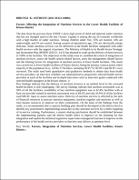| dc.description.abstract | BIRUNGI K. ANTHONY (2011-M121-10004)
Factors Affecting the Integration of Nutrition Services in the Lower Health Facilities of Kisoro District
The data from the previous three UDHS‟s show high levels of child and maternal under nutrition that has not changed much in the last 15years. Uganda is among the top 20 countries worldwide with a high burden of under nutrition. Among children under five, 33% are stunted, 14% are underweight, and 5% are wasted. Among women of reproductive age, 12% are chronically energy deficient. Some nutrition services can be delivered at the health facilities integrated with other health services with the support of partners. The Ministry of Health in its Health Sector Strategic and Investment Plan (HSSIP) 2010/11-14/15 has planned to scale-up the delivery of these services to 100% at the facilities. The objectives of this study were to: establish the extent of integration of nutrition services, assess the health system related factors, asses the management related factors and the limiting factors for integration of nutrition services in lower health facilities. This study was carried out in lower health facilities of Kisoro district, being the primary contact points where majority of the population lives. All the 37 facilities, including HCIV‟S, HCIII‟s and HCII‟s were surveyed. The study used both quantitative and qualitative methods to obtain data from health service providers; an interview schedule was administered to purposively selected health service providers at each of the facilities and in-depth interviews with an interview guide conducted with selected health managers in the Kisoro district. 4
Key findings indicate that the delivery of nutrition services at an optimal level in the surveyed health facilities is still challenging. The survey findings indicate that nutrition assessment was at 50% of all the facilities, availability of key nutrition equipment was at 42.4%, facilities with at least one provider trained in nutrition assessment were at 69.6% and only 26.9% of all the facilities used MUAC tapes to assess nutrition status. Delivery of nutrition services is affected by the lack of financial resources to procure nutrition equipment, nutrition supplies and motivate as well as train human resources to improve on their commitment. On the basis of the findings from the study, it is recommended that a capacity building plan should be developed at the district level to identify key practitioners implementing actual day-to-day nutrition services for a better targeting of in-service training. Furthermore, a reports sharing mechanism should be established between the implementing partners and the district health office to improve on the planning for this integration and exploit the technical supportive supervision managerial function to improve on the performance of the health service providers so that they may deliver at optimum level.
Key Words: Factors, Integration of Nutrition Services, Lower Health Facilities, Kisoro District. | en_US |


